Abstract. – During the site exploration for the Saarland impact, peculiar stones were excavated at a depth of approx. 30-40 cm using a metal detector. According to analyses with the SEM-EDX, these stones are rare meteorites. This short report is about these analyses of the chondritic material, which provided evidence of the extremely rare meteoritic mineral osbornite, known from only two locations on Earth so far.
1 Introduction
Terrain investigations and material analyses evolved into what is now called the Saarland impact and now includes two 250 m-diameter and 2.3-km diameter craters (Ernstson et al. 2013, 2018) . Surface finds of various impactites with suevites, impact melt rocks, impact glasses, mono- and polymictic impact breccias with impact-specific multiple breccia generations now extend over a roughly elliptical area of about 15 km axis length. Impact evidence is the widespread strong shock effects (shock metamorphism) detected in impactites, which comprise virtually all evidence recorded in impact research. Shatter cones in quartzite rocks add to the clear impact shock evidence (Siegel et al. 2023)
In the course of surveying the terrain and researching the Saarland impact (Nalbach, Saarlouis), Werner Müller, who is well known here as the discoverer of the Impact, sampled a special type of rock a couple of years ago that, according to initial microscopic examinations (optical and electron microscopic) , showed typical features of a meteorite, with a connection with the Nalbach/Saarland impact, which at the time was already considered proven by the extensive and widespread evidence of all common impact findings referred to above. Here we report on an extremely rare meteorite mineral that could be shown to exist in these finds.
2 Osbornite in the strewn field of the Saarland impact
Based on Wikipedia: Osbornite is a very rare mineral from the mineral class of elements (including natural alloys, intermetallic compounds, carbides, nitrides, phosphides and silicides) with the chemical composition TiN and is therefore chemically speaking titanium nitride.
Osbornite crystallizes in the cubic crystal system, but so far has only been discovered in the form of microscopic, octahedral crystals up to around 0.1 mm in size. Osbornite is a typical meteorite mineral that has been detected in 14 meteorites so far. Only two purely terrestrial sites are known: an ore body in Tibet and a site in Bahia (Brazil).
Before we begin with the following illustrations and the explanations of the new findings, the perhaps understandable desire to reveal the location of the discovery must be rejected for understandable reasons.
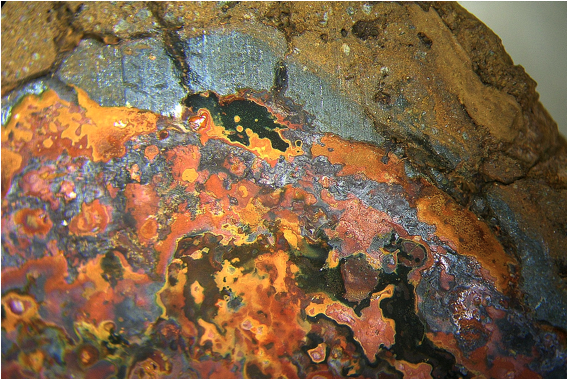
Fig. 1. Section of the examined sample. The sample shape, appearance and size remain “under wraps” for the time being.

Fig.2. Electron microscopic image of a section. 60 µm scale bottom right. Chondritic structure, as known from meteoritic chondrites.
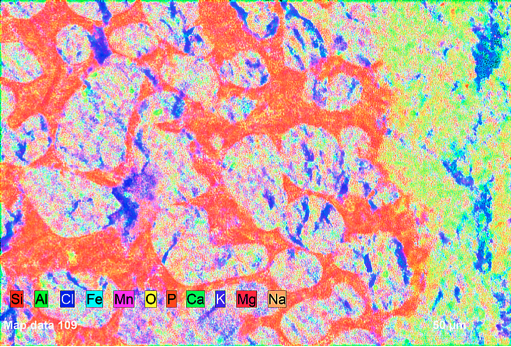
Fig.3. The same section in electron microscopic SEM-EDX element overlay.
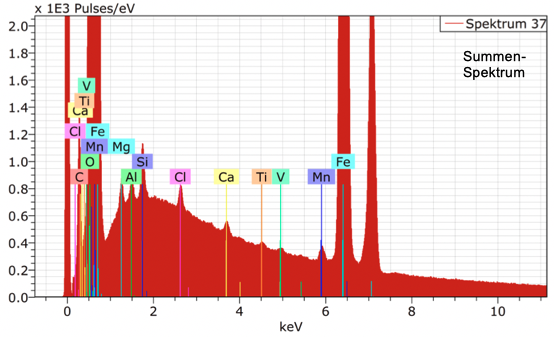
Fig. 4. Sum spectrum of the section from Fig. 3.
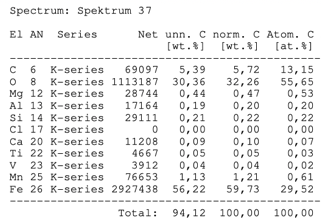
Fig.5. Quantitative analysis of the spectrum. The main components are iron Fe, oxygen O and carbon C. An Fe – O connection can most likely be derived, which may indicate the mineral wüstite FeO, which occurs primarily in meteorites and slags. It remains to be seen whether hematite or magetite may be present. Hematite and magnetite are virtually unknown in meteorites. Another component could be iron carbide Fe3C, which is known as the mineral cementite and, when combined with nickel and cobalt, corresponds to the meteoritic mineral cohenite. The observation that parts of the sawn and polished metallic surface take on a brass color over time speaks in favor of Fe3C. All other elements have an atomic mass of less than 1%.
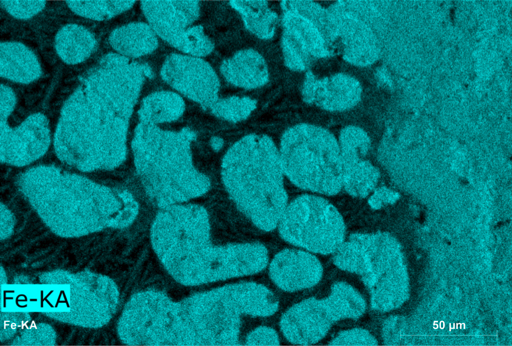
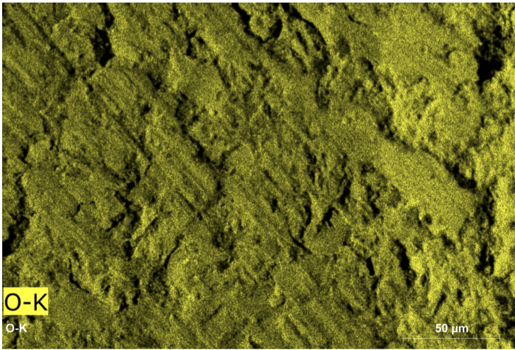
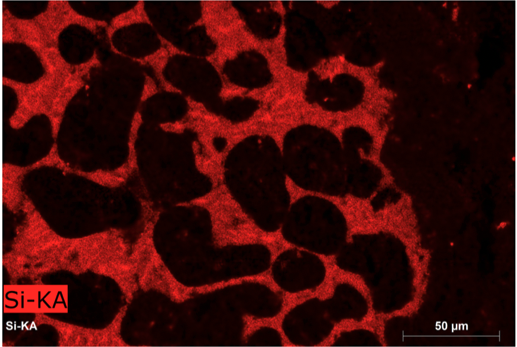
Fig. 6. Color images for the selected elements iron, oxygen and silicon. The correspondence of Fe and O in the chondrules and the marginal matrix supports the assumption of meteoritic wustite. There is practically no silicon in these components, and therefore no silicate minerals.
3 Osbornite – pictures and explanations
When we re-examined the electron microscopic images and analyzes in comparison with samples from the Chiemgau impact, we were surprised by the undoubted evidence of the very rare mineral osbornite, which has practically only been found on Earth in meteorites. Together with the meteoritic minerals titanium carbide and possibly (presumably?) wüstite, it is confirmed that the original assumption of direct involvement of widespread meteoritic material in the Saarland impact strewn field has proven to be correct.
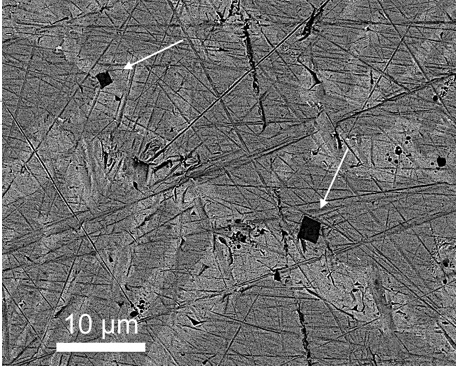
Fig. 7. Electron image of a small section of the sample discussed here with three approximately square inclusions that are only a few micrometers in size, of which the two with arrows were analyzed in detail. The many intersecting lines are an artifact that was created when the surface was polished.
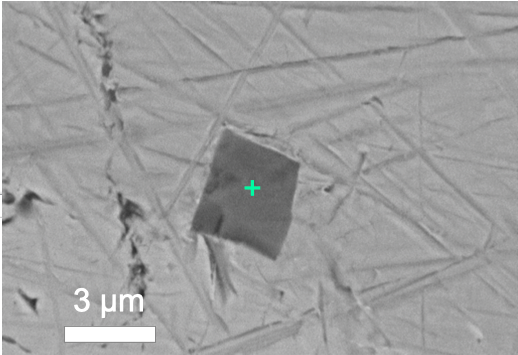
Fig. 8. Crystal from Fig. 7 with cubic crystal structure and chemical composition of titanium, nitrogen and carbon (Fig. 9 and Fig. 10). From this it is practically possible to derive a homeotypic mixed crystal of osbornite (titanium nitride) TiN and titanium carbide TiC, both of which belong to the cubic crystal system. TiC is practically non-existent on Earth and has only been detected in a few places in a combination with vanadium and iron as the mineral khamrabaevite (Ti,V,Fe)C. As a meteoritic mineral, it has been widely analyzed for several years in the crater strewn field of the Chiemgau impact (Ernstson et al. 2023, and references therein).
A probably special “sweet”: mixed crystals made from osbornite and titanium carbide are apparently described here for the first time.

Fig. 9. Spectrum of the measurement at the cross point in Fig. 8.
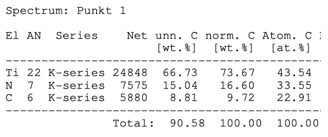
Fig. 10. Quantitative analysis of the spectrum in Fig. 9.
 Fig. 10. The second cubic mixed crystal made of osbornite and titanium carbide with some embedded “foreign material” made of manganese and iron.
Fig. 10. The second cubic mixed crystal made of osbornite and titanium carbide with some embedded “foreign material” made of manganese and iron.
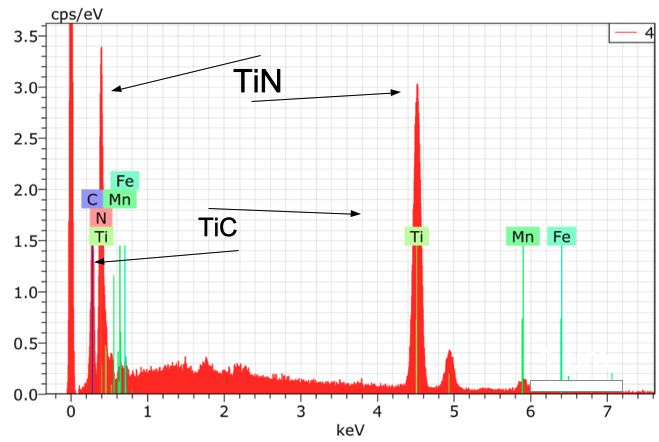
Fig. 11. Spectrum of the measurement at the cross point in Fig. 10.

4 Conclusion
Earlier assumptions have stated that the two impact strewn fields of Chiemgau and Saarland may be attributed to the same Holocene event of a low-altitude touchdown airburst impact, due to the strikingly similar impact findings (typical terrain structures, mineral-petrographically identical impactites) Ernstson et al. 2013). This may perhaps further be supported now by the Saarland meteorite discovery, which may, like with the Chiemgau impact and the new class of iron silicide meteorites there (Ernstson et al 2023), define a new type of a meteorite class (Bauer et al. 2020) , both, although several 100 kilometers apart, belonging to the same giant comet having hit large parts of Central Europe.
Acknowledments. – Many thanks go to Werner Müller who provided the sample discussed here, and to Dr. Michael Hilt, ZEISS GmbH, for for the SEM-EDX analyes.
References
F. Bauer, M. Hiltl, M. A. Rappenglück, K. Ernstson (2020): An eight kilogram chunk and more: evidence for a new class of iron silicide meteorites from the Chiemgau impact strewn field (SE Germany). – Modern Problems of Theoretical, Experimental, and Applied Mineralogy (Yushkin Readings – 7-10 December 2020, Syktyvkar, Russia), Proceedings, 359-360. https://verein.chiemgau-impakt.de/wp-content/uploads/2020/07/Papers-2020-Yushkin-Readings.pdf
Ernstson, K., Müller, W., Neumair, A. (2013): The proposed Nalbach (Saarland, Germany) impact site: is it a companion to the Chiemgau (Southeast Bavaria, Germany) impact strewn field? – 76th Annual Meteoritical Society Meeting, Meteoritics & Planetary Science, Volume 48, Issue s1, Abstract #5058. –
Ernstson, K., Müller, W., Gawlik-Wagner, A. (2018) The Saarlouis semi crater structure: Notable insight into the Saarland (Germany) meteorite impact event achieved. 49th Lunar and Planetary Science Conference 2018 (LPI Abstract 1876)
Ernstson, K., Bauer, F., Hiltl, M. (2023) A Prominent Iron Silicides Strewn Field and Its Relation to the Bronze Age/Iron Age Chiemgau Meteorite Impact Event (Germany). Earth Sciences. Vol. 12, No. 1, pp. 26-40. doi: 10.11648/j.earth.20231201.14 – Open access –
Siegel, U., Müller, W., Michelbacher, S., Rommelfangen, J., K., Ernstson (2023) Shatter Cones in Litermont Quartzites: Saarlouis/Nalbach (Saarland, Germany) Meteorite Impact Event Strengthened. Poster LPSC 2022.












